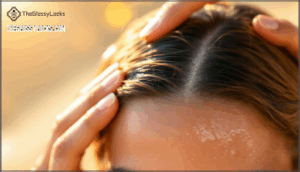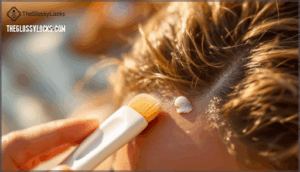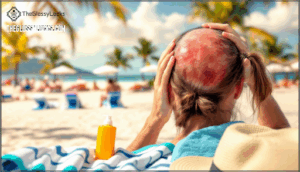This site is supported by our readers. We may earn a commission, at no cost to you, if you purchase through links.
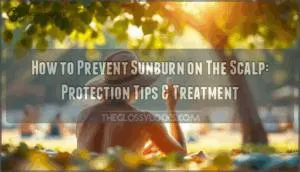
The reality is sobering: scalp melanoma carries a 60% ten-year survival rate, markedly lower than melanomas elsewhere on the body, and men face disproportionately higher risk.
Whether you’re dealing with thinning hair, a fresh part line, or spending hours outdoors, your scalp’s vulnerability to UV damage accumulates silently over years of exposure.
The good news is that preventing scalp sunburn doesn’t require a complete lifestyle overhaul—strategic protection through UPF hats, specialized sunscreens, and smart habits can shield your scalp from both immediate burns and long-term damage.
Table Of Contents
- Key Takeaways
- Why is Scalp Sun Protection Important?
- Best Ways to Prevent Scalp Sunburn
- How to Apply Sunscreen to Your Scalp
- Treating and Soothing a Sunburned Scalp
- Common Complications and When to Seek Help
- Frequently Asked Questions (FAQs)
- What type of sunscreen is best for scalp sunburn?
- How often should sunscreen be applied to the scalp?
- What is the best way to soothe a sunburned scalp?
- Are there any home remedies for sunburn on the scalp?
- Are there any special precautions for balding or thinning scalp areas?
- Can children use adult scalp sunscreen safely?
- Does wet hair increase sunburn risk?
- How does chlorine affect scalp sun protection?
- Are there scalp sunscreens for color-treated hair?
- What SPF level protects tattooed scalps best?
- Conclusion
Key Takeaways
- Scalp melanoma carries a sobering 60% ten-year survival rate—significantly lower than melanomas elsewhere on the body—making proactive UV protection critical since damage accumulates silently over decades of exposure.
- Hair provides only about 50% UV blockage even when thick, and that protection drops sharply with thinning, wet hair, or center parts, leaving exposed scalp vulnerable to burns and long-term cancer risks.
- Effective scalp protection combines UPF 50+ wide-brimmed hats (blocking 98% of UV radiation), oil-free mineral sunscreens with SPF 30+ applied every two hours, and strategic habits like switching your hair part and avoiding peak sun hours between 10 a.m. and 4 p.m.
- If sunburn occurs, immediate cooling with cold compresses and aloe vera gel provides relief, but watch for infection warning signs like oozing blisters, spreading redness, fever, or unusual hair loss—these require prompt dermatologist attention.
Why is Scalp Sun Protection Important?
Your scalp is more vulnerable to sun damage than you might think. While hair provides some coverage, it’s not enough to shield sensitive skin from harmful UV rays—especially along your part, hairline, or thinning areas.
Understanding why scalp protection matters will help you take the right steps to prevent burns, discomfort, and long-term risks.
Risks of UV Exposure on The Scalp
Think of your scalp as a sunroof you can’t close—it’s catching UV rays whether you realize it or not, and that constant exposure carries serious risks you shouldn’t ignore. UV damage accumulates over time, leading to skin lesions, premature aging, and increased cancer risks.
Your scalp is particularly vulnerable because it’s directly exposed without the benefit of clothing, making it a prime target for UV rays that can trigger scalp conditions and even contribute to hair thinning while raising your chances of skin cancer.
Hair’s Limited Protection Against Sun
You might assume your hair acts like a built-in umbrella, but the reality is that even a full head of hair only blocks about 50% of UV radiation—and that protection drops sharply if your hair is wet, thin, or styled with a part. Here’s why your hair isn’t the shield you think it is:
- Dark hair offers slightly more UV blockage than lighter shades, but still falls short of complete protection.
- Hair thinning progressively exposes your scalp to direct UV rays, increasing scalp sensitivity dramatically.
- Wet hair clumps together, creating gaps that allow UV damage to reach your skin.
- Center parts create highways for sunburn, leaving vulnerable strips of exposed scalp.
- Protective styling helps somewhat, but doesn’t replace sunscreen or hats for reliable coverage.
Skin Cancer and Scalp Vulnerability
The scalp isn’t just another patch of skin—it’s a hotspot for aggressive melanomas that account for 35% of all head and neck melanoma cases. UV damage accumulates silently over decades, and scalp melanoma carries a sobering 10-year survival rate of just 60%. Men face six times the risk women do, particularly as hair thins and exposes vulnerable skin to relentless UV rays.
Your scalp is a melanoma hotspot with a chilling 60% ten-year survival rate—UV damage accumulates silently for decades before striking
Genetic factors and chronic sun exposure compound these cancer risks, making your dermatologist’s advice about scalp protection genuinely life-saving. Understanding skin cancer risks is essential for effective prevention and treatment.
Overlooked Areas: Parts, Hairlines, and Bald Spots
Even the most diligent sunscreen users forget about their hair part—that exposed strip of skin soaking up UV rays every time they step outside.
Your hairline and crown are equally vulnerable, especially if you’re dealing with thinning hair or bald spots.
These overlooked zones need dedicated scalp sunburn prevention—think targeted sunscreen application and strategic hat coverage to keep scalp exposure in check.
Best Ways to Prevent Scalp Sunburn
Protecting your scalp from the sun isn’t complicated, but it does require a bit of strategy. The good news is you’ve got several effective options at your disposal, from the gear you wear to simple habit changes.
Let’s walk through the most reliable ways to keep your scalp safe when you’re spending time outdoors.
Choosing UPF 50+ Hats for Maximum Coverage
Think of a UPF 50+ hat as your scalp’s personal shield—blocking 98% of harmful UV radiation before it reaches your skin. Look for hats with a brim of at least 3–4 inches, which covers your scalp, face, ears, and neck.
Materials matter too: polyester and nylon fabrics offer higher UPF ratings than cotton due to their tighter weave. Darker colors absorb more UV rays, boosting protection even further.
When choosing a hat, consider the importance of proper sun protection measures to guarantee maximum coverage.
Using Non-Greasy Sunblock Spray on The Scalp
Spray-on sunscreens designed for scalp use are a breakthrough if you want UV protection without the greasy residue that weighs hair down or leaves it looking slick.
Look for oil-free formulas with SPF 30 or higher containing zinc oxide or titanium dioxide—these mineral ingredients provide broad-spectrum defense.
Position the spray 4–6 inches from your scalp and apply generously along your part and hairline.
The beauty of these products? They absorb quickly and won’t leave your hair flat or shiny.
Switching Up Your Hair Part to Reduce Exposure
If you’ve been wearing the same part for years, you’re basically painting a target line for UV rays to hit the exact same strip of scalp every single day. That’s why switching up your hair part every few days is one of the simplest protective styling moves you can make.
By redistributing scalp exposure, you give previously sun-drenched skin a break while your hair provides natural sun protection to different areas—it’s like rotating crops for your scalp’s health.
Seeking Shade and Avoiding Peak Sun Hours
The best defense isn’t always what you put on your skin—sometimes it’s simply not being in the sun’s crosshairs when UV rays are at their most intense. Between 10 a.m. and 4 p.m., the sun’s angle delivers maximum UV damage to your scalp—even through hair.
Smart timing and shade structures are your allies:
- Check UV forecasting apps before heading out to plan outdoor scheduling around lower-risk hours
- Seek canopies, umbrellas, or trees when you’re outside during peak hours
- Layer shade strategies with your hat and sunscreen for complete UV protection
- Remember that sunburn risk doesn’t disappear in shade—reapply protection consistently
Protective Hairstyles and Accessories
Your hairstyle isn’t just about aesthetics—it can be a surprisingly effective first line of defense against UV damage. Braids, buns, and twists minimize exposed scalp surface area, while headbands and scarf wraps add UPF clothing layers.
Hair ties secure protective styles, and turbans offer full coverage when a hat feels too casual. Hair clips can strategically reposition your part throughout the day, preventing concentrated sun exposure on one narrow strip of scalp.
How to Apply Sunscreen to Your Scalp
Applying sunscreen to your scalp isn’t quite like slathering it on your arms—you need the right formula and technique to protect your skin without ending up with greasy, weighed-down hair.
The key is choosing products designed for this tricky area and knowing exactly where and how to apply them.
Let’s walk through the practical steps that’ll keep your scalp protected while your hair stays fresh.
Selecting The Right Sunscreen Formulation
Regarding scalp sunscreen, not all formulations are created equal. You’ll want to choose between mineral-based sunscreens with zinc oxide or titanium dioxide for sensitive skin, or chemical options if you prefer lightweight absorption.
Spray formats work brilliantly for quick coverage across your whole scalp, while powder sunscreens keep things matte and oil-free.
Stick to SPF 30 or higher—ideally SPF 50 for maximum protection—and look for water resistance if you’ll be sweating or swimming.
Techniques for Applying to Parted or Thinning Hair
Once you’ve chosen your formula, applying it to parted or thinning hair takes a bit of strategy—you’re basically painting sunscreen onto exposed skin without turning your hair into a greasy mess.
- Part your hair in sections and dab scalp sunscreen directly along each exposed strip of skin
- Use your fingertips or a sunscreen brush to gently press product into visible scalp without oversaturating strands
- Focus on the hairline and crown where thinning coverage leaves skin most vulnerable
- Switch up your hair parting every few hours to prevent one area from getting overexposed
Using Brush-on and Stick Sunscreens
Brush-on and stick sunscreens make the whole application process less messy and more precise—think of them as the difference between painting with a roller versus a fine-tipped brush. Sunscreen sticks glide directly onto your part without dripping, while brush applicators let you dust mineral formulas along your hairline like a pro.
Look for oil-free products or scalp serums with SPF 30 or higher—they absorb quickly and won’t weigh down your hair.
Combining SPF Foundations and Powders for Extra Defense
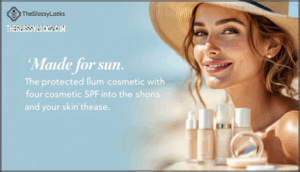
If your hairline or part gets exposed throughout the day—say, when your hat comes off or your hairstyle shifts—layering cosmetic powders or foundations with SPF 15 or higher can fill the gaps in your defense. Mineral makeup works particularly well here since mineral-based sunscreens won’t clog your pores or feel greasy.
Think of cosmetic SPF as your backup plan—it’s not a substitute for proper sunscreen, but it adds another layer of daily protection that fits seamlessly into your makeup routine without extra effort.
Tips for Reapplication and Consistency

Applying sunscreen once won’t carry you through a full day outdoors—UV protection breaks down with sweat, water, and time, so reapplication isn’t optional if you want consistent coverage. Set a timer for every two hours, or more often if you’re swimming or sweating heavily.
Making SPF part of your daily routine—like brushing your teeth—turns sun protection into a habit rather than an afterthought.
Treating and Soothing a Sunburned Scalp

If you’ve already gotten burned, don’t worry—relief is within reach. The key is to act quickly and treat your scalp gently while it heals.
Here’s what you need to know to calm the sting, speed up recovery, and avoid making things worse.
Cooling The Scalp With Water or Compresses
The moment your scalp starts to feel like it’s radiating heat, your first mission is to cool things down—and fast. Cold water therapy is your best friend here—hop in a lukewarm shower or gently rinse the area to halt that inflammatory process.
Here’s your cooling protocol:
- Apply cold compresses for 10-15 minutes at a time—never ice directly, as it can worsen tissue damage.
- Spritz with cooling gels or soothing sprays containing aloe vera gel to calm irritated skin instantly.
- Repeat every few hours to keep inflammation in check and ease that burning sensation.
Pain and Itch Relief: OTC Medications and Home Remedies
As soon as that burning sensation shifts into relentless throbbing or itch, over-the-counter options and simple home remedies can bring real relief. Ibuprofen or aspirin work wonders as pain relievers, tackling inflammation from the inside out.
Apply hydrocortisone cream to ease stubborn itch, or reach for aloe vera gel—nature’s cooling balm. A cold compress delivers instant comfort, while oatmeal baths soothe larger affected areas when sunburn treatment becomes a full-scalp affair.
Moisturizing and Healing With Aloe Vera, Oatmeal, and Green Tea
Your scalp’s recovery hinges on three gentle powerhouses that calm inflammation and lock in moisture: aloe vera, oatmeal, and green tea. These natural healing agents speed up sunburn treatment while soothing raw skin:
- Aloe vera gel reduces redness and delivers anti-inflammatory relief
- Oatmeal rinse alleviates itch and moisturizing dryness
- Green tea compresses calm inflammation with antioxidants
- Cold milk dips accelerate healing through protein-rich hydration
Avoiding Further Irritation and Promoting Recovery
Protecting your sunburned scalp goes beyond just applying treatments—it’s about avoiding anything that could slow down healing or worsen the damage. Skip hot showers, harsh shampoos, and tight hairstyles that create friction. Your scalp needs room to breathe and repair itself properly.
| Avoid These Irritants | Why It Matters for Skin Healing | Better Alternative |
|---|---|---|
| Hot water & heat styling | Increases inflammation, delays recovery | Cool rinses, air-drying hair |
| Alcohol-based hair products | Strips moisture, worsens dryness | Gentle, fragrance-free formulas |
| Scratching itchy areas | Risks infection, disrupts hair regrowth | Cold compresses, hydrocortisone cream |
| Tight hats or headbands | Creates friction on damaged skin | Loose, breathable cotton caps |
| Sun re-exposure | Compounds UV damage to healing tissue | Stay indoors during peak hours |
Keep your scalp care routine minimal—think aloe vera gel for hydration and gentle touches only. This downtime allows your body to focus on sunburn relief and itch prevention without interference.
Common Complications and When to Seek Help
While most scalp sunburns heal on their own, it’s important to recognize when something’s going wrong. Some complications can turn a simple burn into a more serious problem that needs professional attention.
Here’s what to watch for and when it’s time to call in backup.
Symptoms: Redness, Peeling, and Hair Loss
Redness usually shows up within three to five hours after sun exposure, peaking at the 24-hour mark. You’ll notice scalp redness paired with warmth and tenderness, signaling inflammation response from skin damage.
Sunburn peeling usually starts around seven to ten days later, resembling dandruff with flaky white bits.
Severe burns can trigger hair thinning—not because follicles are destroyed, but because inflammation disrupts growth cycles and makes strands brittle and prone to breakage.
Infection Risks and Warning Signs
Sunburned scalp skin is an open door for trouble—bacterial folliculitis strikes over 40% of complicated cases, while fungal infections creep in about 15–20% of the time, especially in humid weather. Watch for these infection symptoms:
- Yellow or greenish crusting with oozing pus signals bacterial invasion
- Spreading redness, swelling, and persistent pain beyond typical sunburn discomfort
- Foul odor or worsening itch suggests colonization by bacteria or fungi
- Red streaks radiating outward demand urgent medical attention for possible lymphangitis
Postburn care matters—immediate cleansing cuts infection risk by 40%, while scratching raises it markedly through microtrauma and skin damage.
Adapting Protection for Thinning Hair
Thinning hair changes the rules—what once shielded your scalp now leaves wider gaps where UV rays sneak through and do real damage. You’ll need to double down on sun protection for hair: layer scalp-specific sunscreen products through exposed areas, switch your hair part weekly, and add protective styling like loose braids.
Consider hair thinning solutions and scalp coverage tips—wide-brimmed hats work wonders for hair loss prevention and complete hair and scalp care when follicles can’t defend themselves.
When to Consult a Dermatologist
Most sunburns clear up on their own, but some warning signs mean you need professional eyes on your scalp—not just patience and aloe. Seek medical attention if you develop blisters that ooze or crust (signs of skin infection), notice unusual hair loss beyond typical peeling, or experience fever and chills. Severe sunburn with extreme pain warrants a dermatologist referral.
Regular dermatology check-ups help catch early skin cancer changes before they become serious problems.
Frequently Asked Questions (FAQs)
What type of sunscreen is best for scalp sunburn?
Look for oil-free, water-resistant mineral sunscreens with SPF 30 or higher. Brush-on powder formulas work best—they won’t leave your hair greasy and absorb quickly into parted areas and thinning spots.
How often should sunscreen be applied to the scalp?
Picture yourself poolside at noon, diligently applying sunscreen but forgetting your scalp entirely.
Reapply sunscreen to your scalp every two hours, or immediately after swimming or sweating heavily, to maintain effective UV protection and burn prevention throughout the day.
What is the best way to soothe a sunburned scalp?
Cool water is your first line of defense—shower gently to calm inflammation, then apply aloe vera gel or a cold compress for relief.
Hydrocortisone cream reduces swelling, while an oatmeal rinse or green tea soothes irritation and speeds healing.
Are there any home remedies for sunburn on the scalp?
Yes, several home remedies can soothe a sunburned scalp effectively. Aloe vera gel provides anti-inflammatory relief, while cold compresses reduce pain.
Try oatmeal rinses for itch, green tea for inflammation, and rosewater spray for calming depuffing effects.
Are there any special precautions for balding or thinning scalp areas?
Bare skin demands vigilance. Thinning hair and bald spots expose your scalp to direct UV assault, so prioritize daily SPF 30+ sunscreen application, even when it’s cloudy.
Wear a UPF 50+ hat outdoors, and consider switching hairstyles to shield vulnerable areas.
Can children use adult scalp sunscreen safely?
Many adult scalp sunscreens work fine for kids, but pediatric sunscreen formulated for sensitive skin solutions is safer. Kid-friendly products avoid harsh chemicals.
Choose gentle formulas—mineral-based options recommended by your dermatologist.
Check labels for child scalp care specifications before applying.
Does wet hair increase sunburn risk?
Notably, dampness can heighten your vulnerability to UV damage. Wet hair offers less protection than dry hair because moisture can magnify sun rays, intensifying exposure on your scalp and increasing sunburn risk—so apply sunscreen and seek shade after swimming.
How does chlorine affect scalp sun protection?
Chlorine strips away natural oils that help shield your scalp from UV damage, leaving skin more vulnerable to sunburn.
It can also trigger scalp irritation and weaken your hair’s protective barrier, amplifying sun sensitivity during pool days.
Are there scalp sunscreens for color-treated hair?
You’ll find plenty of color-safe sunscreens designed specifically for treated tresses. Look for mineral-based sunscreens and chemical-free options that shield your scalp without stripping vibrancy.
These hair-friendly SPF products prioritize gentle hair protection and sensitive scalp care while maintaining your salon investment.
What SPF level protects tattooed scalps best?
For tattooed scalps, SPF 30 or higher is essential. Tattooed skin demands consistent sun protection since ink can fade and sensitivity increases.
Mineral-based sunscreens work well for tattoo aftercare, protecting without irritating your scalp while preserving color vibrancy.
Conclusion
The next time you plan an outdoor adventure, remember: preventing sunburn on your scalp isn’t just about comfort—it’s about protecting yourself from one of the most dangerous forms of melanoma. Your scalp deserves the same vigilant care you give the rest of your skin.
With UPF hats, specialized sunscreens, and consistent reapplication, you’ll turn vulnerability into confidence under the sun.
Start today, because the damage you prevent now could save your life years down the road.
- https://betterscalpcompany.com/blogs/news/upf-hats-and-uv-sprays-reduce-scalp-sun-damage-and-irritation
- https://pmc.ncbi.nlm.nih.gov/articles/PMC9930066/
- https://www.healthline.com/health/hair-sunscreen
- https://www.hims.com/conditions/scalp-sunburn
- https://www.verifiedmarketreports.com/product/hair-sunscreen-market/



